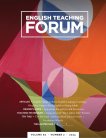
On the Cover: Area Broken by Perpendiculars is an abstract painting by Joseph Schillinger (1895–1943), who was born in Russia, immigrated to the United States, and became an art professor at Columbia University in New York City. Schillinger was also a musician and mathematician; you can see various geometric forms in the cover painting. It is part of the Smithsonian American Art Museum collection, which features more works by Schillinger and by thousands of other artists.
International Subscriptions: English Teaching Forum is distributed through U.S. Embassies. If you would like to subscribe to the print version of English Teaching Forum, please contact the Public Affairs or Cultural Affairs section of the U.S. Embassy in your country.
U.S. Subscriptions: English Teaching Forum is exempted from the Congressional restriction on distribution of Department of State-produced materials in the United States. U.S. residents who want to order the printed edition can order from the U.S. Superintendent of Documents.
Authors Juanita Blackton and Alla McCaughey provide everything you need to plan and conduct a successful English Camp. Their how-to approach offers guidance for selecting a theme and language focus, getting started, setting a positive and inclusive tone, finishing on a high note, and more. You will find plenty of examples and tips, along with QR codes that lead to additional, ready-to-go materials you can use for a camp of your own
Format: Text
Authors Enrique Alejandro Basabe and Mary Beringause present clear, practical suggestions for using pop songs—which most young adults listen to regularly—to teach English and to do much more. The authors argue that “using pop songs in the EFL classroom should follow the principles of meaningfulness, focus on language, criticality, active consumption, and personal growth, and it should encourage the creation of communities of knowledge.” Numerous examples of current and recent pop songs illustrate how teachers can achieve these goals.
Format: Text
This guide is designed to enrich your reading of the articles in this issue. You may choose to read them on your own, taking notes or jotting down answers to the discussion questions below. Or you may use the guide to explore the articles with colleagues.
Author Tom Glass describes multiple ways that teachers can use and adapt “The Lighter Side” puzzles, found in all issues of English Teaching Forum, to give students extended language practice by solving puzzles and creating new puzzles of their own. The article includes examples from puzzles that teachers can find and download (for free) on the American English website.
Format: Text
Would you like to give your students practice in generating and asking questions—and finding creative ways to answer them? Author Terence McLean describes a job-interview activity that is light-hearted and fun, yet gives students serious language practice, motivates them, and requires them to think creatively and critically. The activity also helps students prepare for the real-life job interviews they will have in the future.
Format: Text
This article, by Anestin Lum Chi, offers detailed instructions for making vocabulary wheels and using them in various ways for extended practice with targeted vocabulary. Students can make and use the wheels, and the wheels can be customized and saved for future classes. The wheels are ideal for all language levels and for all contexts, including those with limited resources. No internet connectivity is required.
Format: Text
These days, “AI” usually means “artificial intelligence,” but in this puzzle, “AI” is used as a substitute for other two-word terms and phrases. The only requirement is that the first word must begin with the letter “a,” and the second word must begin with the letter “i.” Can you find every AI in this puzzle?